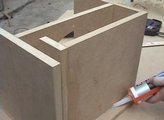Building Car Audio Subwoofer Boxes
Now that you know about subwoofer enclosures it's time to learn about building subwoofer boxes. If you've done any woodworking you shouldn't have much trouble when building a subwoofer enclosure. One of the main differences will probably be the material used in building subwoofer boxes as compared to other woodworking projects.
Building a Custom Car Audio Subwoofer Box
Because a subwoofer enclosure needs to be very strong we will use a composite wood rather than a natural wood. When building a custom subwoofer box you will want to use either MDF (medium density fiberboard) or if that's not available, a high grade particle board. Marine grade plywood is also a popular option with some builders. All are available at lumber yards and home improvement centers. Expect to pay about $30 for a 3/4" sheet (4' x 8'). The larger your enclosure and the more power your woofers will receive the thicker the wood you will need to use. Generally you can get away with 1/2" for 8" woofers and 5/8" for 10" woofers but anything larger should probably use 3/4" or 1". You can use thicker wood and the only real disadvantage is the weight it will add. Better too thick (which adds rigidity) than too thin. One inch MDF is available but can be hard to find. Well braced 3/4" should be sufficient for nearly any enclosure.
Keep in mind the pressure inside the enclosure is what determines the rigidity the enclosure needs. So if you have a woofer with a small cone area, only a small amount of power going to the woofer and a small enclosure than you will not need as rigid an enclosure as if you had a large woofer, lots of power and a large enclosure. Enclosure wall thickness adds rigidity but so does bracing. It's often more effective to brace the enclosure than to double up the wall thickness. So remember that both wall thickness AND bracing increase the rigidity of the enclosure.
You will want to hold the subwoofer enclosure together with a combination of wood glue and 1.5" drywall screws. And always counter sink your screw holes so you don't split the wood. There is even a type of drill bit available at home improvement or hardware stores that both drills the pilot hole and countersinks the drywall screw head. Use a tube of silicone caulk to seal any gaps in the enclosure seams. This is very important when building subwoofer boxes. Polyester fiberfill, available in the crafts department of hobby or fabric stores (even places like Wal-Mart), will help even out the sound of your subwoofer enclosure. Generally around one pound (about one average bag) per cubic foot is what you want. But experiment with the density to see what works for your project.
That's the raw materials you'll need when building a custom subwoofer box but you'll also need some subwoofer enclosure "accessories". This includes the speaker wiring, subwoofer mounting ring/grill, enclosure carpeting (if desired), terminal cup and port tube if designing a ported/vented or bandpass subwoofer enclosure. You can get these locally but will probably pay more than you have to. A good source of parts for the DIY'er is Parts Express. Here is a list of the part numbers most often used when building subwoofer boxes. This list will keep you from having to search through the catalog every time you place an order.

Click here to get the details.
Next Page ---> Subwoofer Enclosure Software